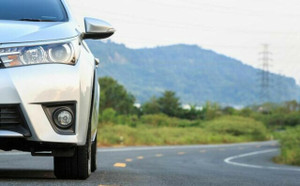Buying green: The ecological impact of buying a used car vs. a new car
By Kijiji Autos
There are 7.4 million vehicles registered in Ontario alone, so it would require 814 million trees to offset the 28 billion kilos of CO2 that those vehicles will produce over their 12-year (average) lifespan.
In a continuing effort to take better care of our planet, many people are considering the ecological impact of the items they purchase. Trees take in carbon dioxide (CO2) and expel oxygen (O2), which is useful to pretty much every living species on the planet, even those living in the water.
Cars do the exact opposite – consuming O2 and expelling CO2 (among other toxins) – and it takes approximately 110 trees to counteract the carbon dioxide emitted by just one vehicle over its lifetime. To put that into perspective, there are 7.4 million vehicles registered in Ontario alone, so it would require 814 million trees to offset the 28 billion kilos of CO2 that those vehicles will produce over their 12-year (average) lifespan.
Earth has a finite amount of resources, and it’s up to us to ensure that the planet will be able to sustain life for future generations. To that end, each of us can make more environmentally conscious decisions. One of them would be changing the type of vehicle that we choose to drive. But which would have a lower “carbon footprint”, a new car or a used car?
- Burning 1 litre of gasoline produces 2.3 kg of CO2
- A vehicle with an average fuel economy of 9.4L/100km produces 2,163 kg of CO2 every 10,000 km
The Ecological Impact of Buying New Cars
“Nothing ages your car as much as the sight of your neighbor’s new one.”— Evan Esar
Burning fossil fuel releases energy used to propel a vehicle down the road, but it’s also used to manufacture the auto in the first place. Creating this energy releases carbon dioxide and other toxins into the atmosphere. These environmental affects create a vehicle’s “carbon footprint”, which is a measure of its impact on the planet.
According to a study conducted in 2004 by Toyota, 28% of the carbon dioxide emissions emitted over a vehicle’s lifetime are produced when it’s manufactured. A separate MIT study found that producing the raw materials needed to make an average-sized car (steel, rubber, plastic, etc.) releases 1,580 kg of carbon dioxide into the atmosphere. Another 810 kg of CO2 are released when processing recycled materials.
That doesn’t even take into account the amount of additional greenhouse gases produced by the car company’s assembly plants, or the freighter ships and 18-wheel car transporters needed to deliver a new car to the dealership. So Toyota’s numbers seem to be spot-on.
Automotive Recycling
In the early 2000’s, over 14 million vehicles a year were being recycled in the U.S. & Canada. At the time, 75% of a vehicle’s weight was being repurposed as raw material to be used in other products. But instead of just melting everything down, automotive recyclers (aka salvage yards) remove reusable components (alternators, seats, airbags, etc.) from a junk vehicle, then they rebuild the part before re-entering it back into the supply chain.
This auto part reuse keeps approximately 99.7 million kilos of carbon dioxide from entering the atmosphere, because a brand new version of that part doesn‘t have to be made. The recyclability of new cars is expected to exceed 85% by 2015.
The other 15-25% of a junk vehicle’s weight is sent to landfills, resulting in nearly 5 million tonnes of unprocessable materials (foam, certain plastics, electronic components) being buried in the earth in North America.
Given the skyrocketing popularity of features like big touchscreens and hybrid batteries, an increasing percentage of that waste increasingly includes heavy metals and toxic chemicals needed to manufacture such features.
In the time since those figures were tabulated, automakers have begun to take steps to reduce the amount of toxins used to make a car. Hybrid battery recycling programs are also being “fast tracked”.
The Ecological Impact of Buying Used Cars
So before a new car even hits the road, its very existence has released thousands of kilos of CO2 into the atmosphere. Then after chugging through countless barrels of fuel throughout its life, that new car then turns into a junk car and pollutes the earth one last time in the landfill. But another option is the ultimate recycling program that rose to popularity long before ‘buying green’ was even fashionable – buying a used car.
In contrast to new cars, used cars have already expelled the largest part of their carbon footprint. In a sense, keeping a used car from entering the junk car phase prolongs its final landfill impact. Naturally, a used vehicle’s carbon footprint does depend on the emissions from its engine and its overall condition.
But other than that, the additional carbon footprint of a used car is essentially limited to the emissions created by the vehicles driven to and from the place where the used car is purchased.
The Future
In an effort to reduce the car’s environmental impact, automakers are starting to use more recycled and biodegradable materials.
They’re also spending fortunes on component recycling technology that will significantly reduce the amount of hazardous and non-biodegradable materials polluting landfills.
In the meantime, you can make a difference by driving responsibly (i.e., conserving fuel), and picking the most efficient vehicle based on your intended use, and considering if a used car will fit your wants and needs just as well as a new one.
Easily find your next ride on Kijiji Autos
Search nowThe most affordable electric cars in Canada in 2023
Looking for a budget-friendly electric car? Discover the 12 most affordable electric cars for sale in Canada on Kijiji Autos. Plus, we answer your FAQs about the costs of driving, charging and insuring an electric car.FWD vs AWD: What’s the Difference & What’s Right For You?
The main difference between FWD and AWD vehicles is the number of wheels their engines are able to send power to. This article will tell you everything you need to know about FWD vs. AWD and help you decide which is right for you.2023 Mazda 3 GX vs GS: What’s The Difference?
The 2023 Mazda 3 is a refined compact car with styling and performance that give it a upmarket feel. In this article we'll break down the differences between the Mazda 3's GS and GX trim packages to help you decide which features you'd want to take or leave, as well as what they'd cost you. Click on the listings on our Search Results page to discover the Mazda 3 GX and GS for sale near you.Coupe vs Sedan: What’s The Difference?
Coupes and sedans can both provide you with practical, fuel efficient transport that can also be fun to drive. Both body styles have their advantages and drawbacks depending on what you’re looking for in a new vehicle. In this article we’ll examine the differences between coupes and sedans and define both vehicles with examples.Is it hard to drive an SUV?
if you're stopping yourself from buying an SUV because you're afraid it's more difficult to maneuver, you'll be pleased to know that's not the case. In fact, first-time drivers will find driving an SUV no more challenging than smaller vehicles like sedans, as long as they follow a few tips outlined below.Top 11 SUVs for Winter Driving in Canada
SUVs are some of the best-suited vehicles for winter conditions with a wealth of standard and available features to help you stay in control and get where you're going when the temperature plummets below zero. Here are 11 of the top SUVs for winter driving.Sedan vs SUV: Which one is right for you?
Sedans and SUVs are two of the most popular kinds of vehicle on the market today. This article will examine the different characteristics of sedans and SUVs, highlighting the areas in which each shines and where their shortcomings lie to help you make the right choice on your next vehicle.Top 5 Electric Vehicles for Families
Below are five choice options from the best electric family vehicle market. Listed in no particular order, these are a few of the brands available for growing families.How Long Does It Take To Charge An Electric Car?
There are a number of factors and conditions that affect how long it takes to charge an electric car, and in this article we'll discuss them with their various effects.Electric car charging guide and chargers
Electric vehicles (EVs) are an ever-growing part of Canada's transport landscape with one in twenty new cars registered in 2021 being fully electric. The Government of Canada is hoping that by 2040 100% of light-duty car and truck sales will be made up of zero-emission vehicles (ZEVs).









